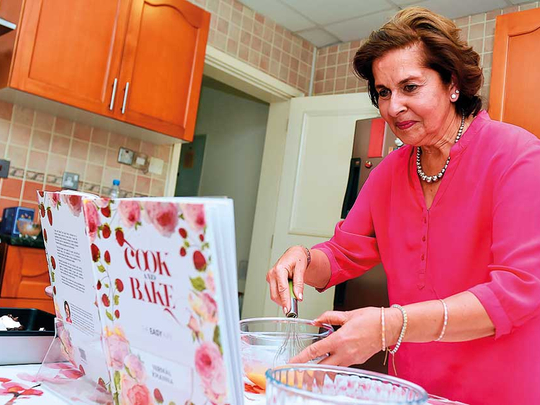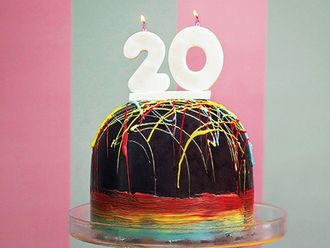
Nirmal Khanna is busy demonstrating her favourite recipe for cupcakes when I walk into the kitchen of her sunny villa opposite Dubai’s Safa Park. If I ignore my colleague Clint Egbert directing her from behind his camera, she could be teaching cooking again, as she did for several years when her bank executive husband was being posted across the length and breadth of India in the Eighties.
I watch avidly as she goes through the motions, deftly stirring the mixture with practiced ease. No kitchen shortcuts for this hostess with the mostest, everything’s pulled together the old-fashioned way.
The results have graced dinner tables in the Emirates for nearly 35 years, and have been condensed into a sparkly, new and updated edition of her classic recipe book, Cook and Bake — The Easy Way, a novel introduction to Western food — and baking — by an Indian cook. Home chefs across India and the UAE will remember its text-heavy early versions, first published by India Book House in 1982. Later print runs were distributed in India with products from Delhi-based kitchen appliances brand Nikitasha, and here in the UAE with a local publishing house.
Over the decades, housewives and home cooks have faithfully turned to their dog-eared copies of the book to feed family and entertain dinner party diners with presentations from around the world (among the cuisines represented are German, Italian, French, Russian, American and Thai).
A former journalist who also spent time at Gulf News, the Indian expatriate wasn’t always a great cook, although she’s now been cooking for close to 50 years. She relates how she was married early, as a post-graduate still finishing her Master’s in English. She didn’t know how to cook; as remains common in much of upper middle class India, she had a personal chef or khansamma. But like every other hostess in history, she wanted to be able to serve unusual dishes when she entertained.
When her husband was transferred to Madras (now Chennai) in the Sixties, she was disappointed that the local bakery sold little beyond bread and basic cakes; the norm, even in most restaurants, was traditional South Indian fare such as dosas and coconut curries.
“Madras was very much an extension of the Raj in the Sixties, with black-tie dinners and so on, and I wanted to be able to impress my guests, but I couldn’t cook very much,” she says, breaking into Hindi for a moment. “An American friend took pity on me and taught me the basics of shortcrust pastry, and that set me off!” she exclaims.
From the start, she focused on Western food, which proved extremely popular as she and her husband moved around India for over two decades.
Briefly based in Kolkata in the Seventies, she began to teach cooking, to groups of seven women on the veranda of her home. “I started because we had to pay to send our sons to boarding school — the constant movement wasn’t good for them, and they had to learn a different regional language in each state,” she says. The classes were the idea of her Bridge partner, fashion designer Ritu Kumar, who also got Khanna her first class of seven students. “From there, it was 10 years of non-stop teaching, 24 students a year, and all year round.”
One student had a connection with a publisher, and the idea of the book was born.
She has no idea how many copies have been printed over the years, since there was at least one print run she didn’t know about, never mind any royalties. She seems to be amazed its lasted this long and tells me how she was invited to dinner at the home of one of the owners of a large Indian private sector bank last year, only to be served one of her own classic moulded salads.
“She’s seriously rich,” Khanna says of her friend, “So she could have ordered things from anywhere, but lo and behold I find my jellied salad there! I asked her about it, and she said she’d been cooking it for years, that it’s always one of the most popular dishes at her parties.
“At the time we were halfway through the backbreaking task of editing this new version — with an entirely new chapter on salads — and we quickly brought back a couple of the original jellied salads.”
The dish in question is an eye-catching salmon mousse shaped like a fish (with cucumber slices for scales), and straightaway it takes me back to the few eighties house parties that I was allowed to stay up late for as a child. Alongside a moulded carrot and egg crowned salad, it’s one of several retro but on-trend recipes in the new volume; they sit next to the lighter, more international fare that speaks to the way we eat now. There are salads that use quinoa, kale and pumpkin, and guilt-free soups and vegan puddings.
“It’s imperative to keep up with current trends,” the grandmother of four says, explaining how she’s left out about a hundred recipes, at least as many as are included. “Since it was going to be a coffee-table book, we didn’t want it to get too busy.”
Consequently, several classic preparations have been adapted to today’s lifestyles and intolerances, and over the seven sections, harried cubicle slaves will find tried and tested dishes that can be fixed in advance, such as a Middle Eastern spinach and chickpea salad that can be made on the morning of a party, or Khanna’s classic frozen chocolate cake, which she says can be finished and frozen weeks ahead of time. (One of my favourites is a date chutney that Khanna invented when presented with a wheelbarrow full of fresh dates here in Dubai).
The project took eight months to finish, says editor Jenna Wall, and the new edition is a tribute to Khanna’s late husband, Harish, with proceeds from the print run of 2,000 copies to go to three charities in India and the UK: Amar Jyoti, set up to educated disabled children in New Delhi, Wishing Well, which matches resources to organisations that need them, and Elephant Family, a British trust whose mission is to save the Asian elephant from extinction.
Khanna is closely associated with the first two, which are run by family and close friends. “So I’ve seen them grow, I know the people personally, and I’ve seen the benefits of their work.” The third is Wall’s pick; it speaks to the UK national’s love for India.
With its mix of classics and new recipes, Cook and Bake fits right in with the retro food movement we’re savouring at the moment, with dishes such as lobster Thermidor appearing on restaurant menus everywhere. I find myself coming back to monkey bread, which has been everywhere recently, from Buzzfeed’s Tasty channel to Yottam Ottolenghi’s Easter column in the Guardian. The version in the box alongside, sugar bubble ring, is an irresistible sweet variation.
But it is also very much a chronicle of our times, a nostalgic run through licence-era India, before liberalisation brought foreign ideas and ingredients — and cookware. Another dessert, Pineapple fluff, is pictured served in individual glasses, but when Khanna made it regularly in the seventies and eighties, she used Pyrex. “That sort of stemware just wasn’t available in India at the time, it all had to be imported,” she says earnestly. “So we had to be inventive.”
Thankfully, that spirit has made it into the new book, and with Ramadan ahead of us, it’s the perfect treasure trove for family-friendly ideas and iftars.
Check it out!
Cook and Bake — The Easy Way is available exclusively at Amar Jyoti Charitable Trust in Delhi and can be shipped to Dubai. 100 per cent of the proceeds go to the charity.
Sugar Bubble Ring
Ingredients
■ 1 ½ tbsp yeast
■ ½ cup milk
■ 1 ¼ cups sugar
■ 1 cup butter
■ 2 eggs, beaten
■ 3 ¾ cups flour
■ 2 tsp cinnamon powder
■ ½ cup candied cherries, halved
■ ½ cup almonds, blanched
■ 1/3 cup golden syrup
Method
1. Sprinkle the yeast into 1/4 cup warm water. Leave until frothy (about 5 minutes)
2. Heat the milk and then allow it to cool.
3. Add 1/3 cup sugar, 1/3 cup butter, eggs and 1 tsp salt
4. Combine yeast and milk mixture in a large mixing bowl
5. Beat in the flour and knead into a soft dough
6. Grease the top of the dough and cover it with a damp cloth or wet plastic sheet
7. Leave the dough to rise for 2 hours. Then punch down to remove some of the air
8. Form the dough into small balls, about the size of a walnut. Dip each ball in melted butter and then in a mixture of 3/4 cup sugar and cinnamon powder
9. Sprinkle candied cherries and almonds in a greased ring mould (8-cup capacity)
10. Arrange a layer with the cinnamon-coated balls, then sprinkle more cherries and almonds, building up mould until all the cherries and almonds are used up
11. Heat 2 tbsp butter together with golden syrup. Pour down the sides and near the funnel of the ring mould
12. Cover the ring mould with a damp cloth and leave to rise for 30 minutes.
13. Bake at 180°C in a preheated oven for about 30-35 minutes. Turn on to a serving dish and serve immediately.












